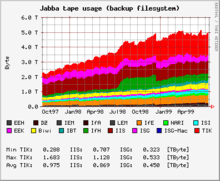RRDtool
 | |
| Original author(s) | Tobi Oetiker |
|---|---|
| Stable release | 1.5.2 / April 24, 2015 |
| Written in | C |
| License | GNU General Public License |
| Website |
oss |

RRDtool (acronym for round-robin database tool) aims to handle time-series data like network bandwidth, temperatures, CPU load, etc. The data are stored in a circular buffer based database, thus the system storage footprint remains constant over time. Note that this is distinct from the computer science concept of round-robin scheduling.
It also includes tools to extract RRD data in a graphical format, for which it was originally intended.
Bindings exist for Perl, Python, Ruby, Tcl, PHP and Lua. And there is an independent full Java implementation, rrd4j.
General data storage
RRDtool assumes time-variable data in intervals of a certain length. This interval, usually named step, is specified upon creation of an RRD file and cannot be changed afterwards. Because data may not always be available at just the right time, RRDtool will automatically interpolate any submitted data to fit its internal time-steps.
The value for a specific step, that has been interpolated, is named a primary data point (PDP). Multiple PDPs may be consolidated according to a consolidation function (CF) to form a consolidated data point (CDP). Typical consolidation functions are average, minimum, maximum.
After the data have been consolidated, the resulting CDP is stored in a round-robin archive (RRA). A round-robin archive stores a fixed number of CDPs and specifies how many PDPs should be consolidated into one CDP and which CF to use. The total time covered by an RRA can be calculated as follows:
time covered = (#CDPs stored) * (#PDPs per CDP) * steps
After this time the archive will "wrap around": the next insertion will overwrite the oldest entry. This behavior in this context is referred to as "round-robin" and is the reason for the program's name. However this is different from the common computer science definition, which is a method of distributing resources among multiple consumers or processes.
To cover several timespans and/or use several consolidation functions, an RRD file may contain multiple RRAs. The data retrieval function of RRDtool automatically selects the archive with the highest resolution that still covers the requested timespan. This mechanism is also used by RRDtool's graphing subsystem.
Release history
| Colour | Meaning |
|---|---|
| Red | Release no longer supported |
| Green | Release still supported |
| Blue | Future release |
RRDTool is sponsored since 1.2, each release comes with a list of sponsors.
The following table contains the release history of RRDtool, showing its major releases.
| Version number | Date | Links | Notable changes |
|---|---|---|---|
| 1.0 | July 16, 1999 | Full release notes, Announce | First release. Basically MRTG "done right". |
| 1.1 | April 25, 2005 | Full release notes, Announce | libart; output EPS, PDF & SVG; VDEF; trends; percentiles; updatev; Holt-Winters Forecasting; COMPUTE; .rrd format change. |
| 1.3 | June 11, 2008 | Full release notes, Announce | Safer & faster file access; cairo/pango; anti-aliasing; TEXTALIGN; dashed lines; new HWPREDICT; libxml; i18n; XML dump; |
| 1.4 | October 27, 2009 | Full release notes, Announce | Caching daemon; VDEF PERCENTNAN; CDEF PREDICT & PREDICTSIGMA; libDBI; graph legends positioning; Lua bindings; 3D border width; and more ... |
| 1.5 | April 16, 2015 | Full release notes, Announce | Use data from callback functions; Population of new rrd files with data from old ones; .NET bindings |
Other tools that use RRDtool as a DBMS and/or graphing subsystem
- BackupPC
- Cacti
- Cherokee
- collectd
- Ganglia – system monitor clusters and grids
- Lighttpd
- Lpar2rrd
- Monitorix
- MRTG
- Munin
- N2rrd
- Nagios
- Nmon
- NMIS[1]
- ntop
- Observium
- OpenNMS
- pfSense
- ServersCheck
- SmokePing - Network latency monitor
- SNM - System and network monitor
- Stor2rrd
- Xymon
- Zenoss